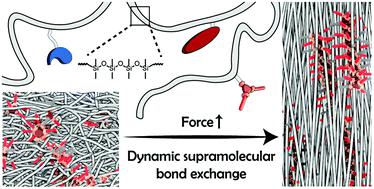当前位置:
X-MOL 学术
›
Polym. Chem.
›
论文详情
Our official English website, www.x-mol.net, welcomes your
feedback! (Note: you will need to create a separate account there.)
Tuning polymer properties of non-covalent crosslinked PDMS by varying supramolecular interaction strength
Polymer Chemistry ( IF 4.1 ) Pub Date : 2020-03-25 , DOI: 10.1039/d0py00139b Brigitte A. G. Lamers 1, 2, 3, 4 , Marcin L. Ślęczkowski 1, 2, 3, 4 , Fabian Wouters 1, 2, 3, 4 , Tom A. P. Engels 2, 3, 4, 5, 6 , E. W. Meijer 1, 2, 3, 4 , Anja R. A. Palmans 1, 2, 3, 4
Polymer Chemistry ( IF 4.1 ) Pub Date : 2020-03-25 , DOI: 10.1039/d0py00139b Brigitte A. G. Lamers 1, 2, 3, 4 , Marcin L. Ślęczkowski 1, 2, 3, 4 , Fabian Wouters 1, 2, 3, 4 , Tom A. P. Engels 2, 3, 4, 5, 6 , E. W. Meijer 1, 2, 3, 4 , Anja R. A. Palmans 1, 2, 3, 4
Affiliation

|
Non-covalently crosslinked polymeric networks are promising materials towards sustainable and recyclable plastics. Here, we present the post-functionalization of poly(dimethyl siloxane) (PDMS) with supramolecular moieties, attached as grafts to the PDMS backbone, to obtain recyclable PDMS networks. We select three different supramolecular motifs that differ in interaction strength and investigate how these differences affect the dynamic behavior of the networks. The introduction of dinitrohydrazones (hydz), which afford weak supramolecular interactions by π-stacking, resulted in a viscous material at room temperature. Stronger self-association was achieved by the introduction of benzene-1,3,5-carboxamides (BTAs) and ureidopyrimidinones (UPys), which self-assemble via triple and quadruple hydrogen bonding, respectively. This resulted in a thermoplastic elastomeric material for BTA-based PDMS and brittle materials for Upy-based PDMS. Time- and temperature-dependent mechanical measurements reveal that the dynamic nature of the supramolecular bonds becomes slower upon increasing the interaction strength. The polymers are fully recyclable by solvation or compression molding without the loss of material properties. Thereby, by using one linear PDMS backbone, we demonstrate how fundamentally different material properties are obtained by changing the supramolecular interaction strength and type of non-covalent crosslinks. These molecular insights broaden the scope and application of PDMS-based sustainable materials.
中文翻译:

通过改变超分子相互作用强度来调节非共价交联PDMS的聚合物性能
非共价交联的聚合物网络是有望用于可持续和可回收塑料的材料。在这里,我们介绍了聚(二甲基硅氧烷)(PDMS)与超分子部分的后功能化,以嫁接的方式连接到PDMS主链,以获得可回收的PDMS网络。我们选择三种不同的超分子基序,它们在相互作用强度上有所不同,并研究这些差异如何影响网络的动态行为。二硝基hydr(hydz)的引入通过π堆积提供了弱的超分子相互作用,在室温下产生了粘稠的物质。通过引入苯1,3,5-羧酰胺(BTA)和脲基嘧啶酮(UPys)可以实现更强的自缔合,它们可以通过三氢键和四氢键。这产生了用于基于BTA的PDMS的热塑性弹性体材料和用于基于Upy的PDMS的脆性材料。时间和温度相关的机械测量结果表明,超分子键的动力学性质随着相互作用强度的增加而变慢。聚合物可通过溶剂化或压模完全回收,而不会损失材料性能。因此,通过使用一个线性PDMS主链,我们证明了如何通过改变超分子相互作用强度和非共价交联键的类型来获得根本不同的材料性能。这些分子见解拓宽了基于PDMS的可持续材料的范围和应用。
更新日期:2020-03-25
中文翻译:

通过改变超分子相互作用强度来调节非共价交联PDMS的聚合物性能
非共价交联的聚合物网络是有望用于可持续和可回收塑料的材料。在这里,我们介绍了聚(二甲基硅氧烷)(PDMS)与超分子部分的后功能化,以嫁接的方式连接到PDMS主链,以获得可回收的PDMS网络。我们选择三种不同的超分子基序,它们在相互作用强度上有所不同,并研究这些差异如何影响网络的动态行为。二硝基hydr(hydz)的引入通过π堆积提供了弱的超分子相互作用,在室温下产生了粘稠的物质。通过引入苯1,3,5-羧酰胺(BTA)和脲基嘧啶酮(UPys)可以实现更强的自缔合,它们可以通过三氢键和四氢键。这产生了用于基于BTA的PDMS的热塑性弹性体材料和用于基于Upy的PDMS的脆性材料。时间和温度相关的机械测量结果表明,超分子键的动力学性质随着相互作用强度的增加而变慢。聚合物可通过溶剂化或压模完全回收,而不会损失材料性能。因此,通过使用一个线性PDMS主链,我们证明了如何通过改变超分子相互作用强度和非共价交联键的类型来获得根本不同的材料性能。这些分子见解拓宽了基于PDMS的可持续材料的范围和应用。











































 京公网安备 11010802027423号
京公网安备 11010802027423号